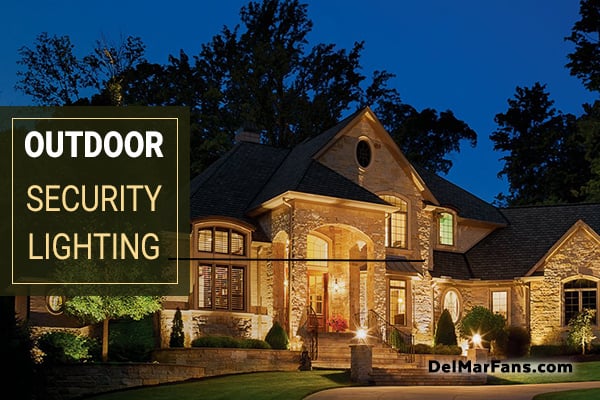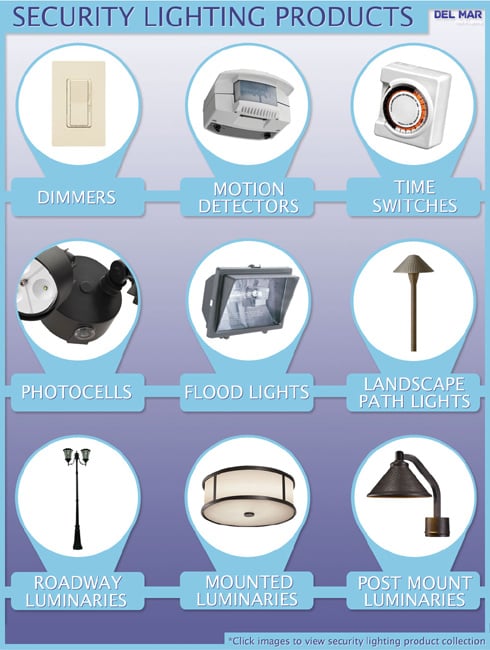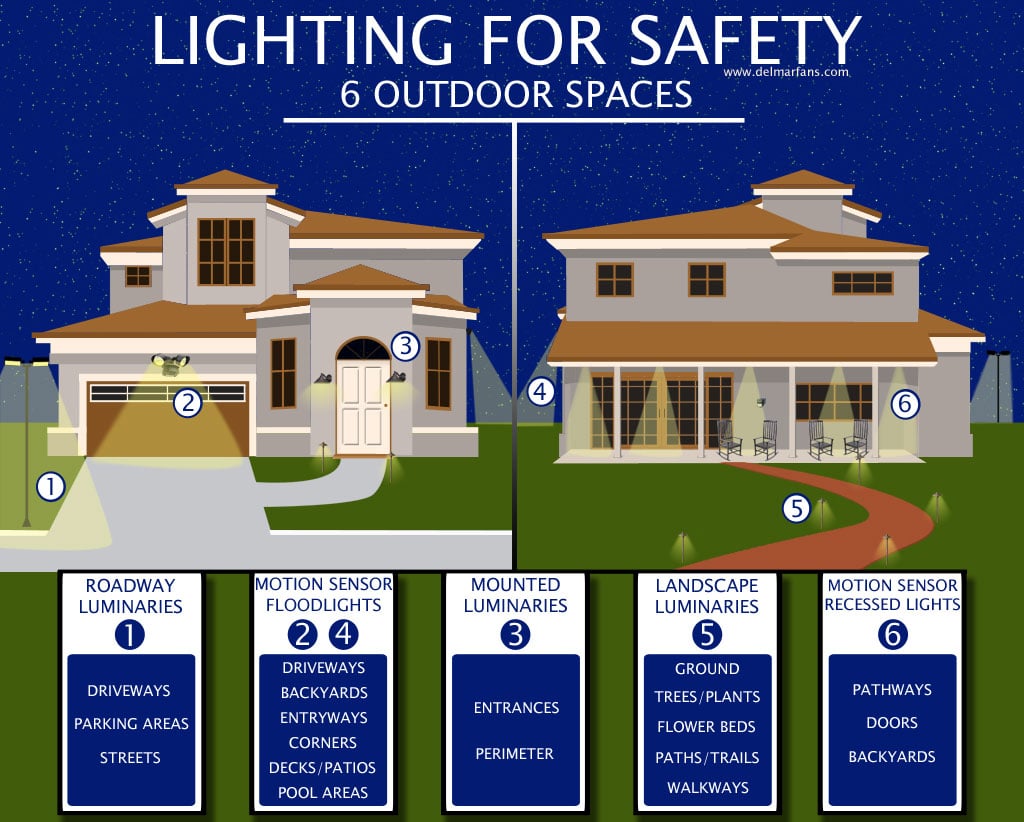
Outdoor lighting adds beauty and dimension to a home. Lighting is also an integral part of an effective home security system. Outdoor security lighting discourages would-be intruders from targeting your home by increasing the risk of being caught. The best lighting design allows physical detection and facial recognition, minimizes hiding spots, and increases your sense of safety.
You don't have to light your home like a Christmas tree to feel safe. Over-illumination can draw unwanted attention to valuable items in your home or business and can cause light pollution. In this guide, we offer an overview of security lighting and simple tips to help you identify potential safety and security risks, select the best security lights, and determine their placement to ensure your safety and security.
- Purpose of Security Lighting
- Types of Security Lighting
- Where to Place Security Lights
- Lighting Controls
- How to Choose Light Sources
- Installation Tips
- Maintenance
The Purpose of Outdoor Security Lighting
Andrew Coleman, a lighting designer for McKay Landscape Lighting in Omaha, NE, reveals the purpose of residential outdoor lighting is threefold. First, it must be aesthetically pleasing to the homeowners. Second, it must help the residents safely navigate the landscape and the perimeter of the home, and allow them to identify obstructions and potential hazards such as a change in elevation. Third, it must provide security by discouraging trespassers. A well-lit home is less likely to be broken into, he says.
A 2007 Washington Post article found burglars search for homes that appear to be unoccupied. Lighting adds an element of surprise and establishes an occupancy pattern that deters intruders from targeting a home in the first place. Residents that use outdoor lighting as part of their security plan significantly decrease their changes of being burglarized.
The Illuminating Engineering Society (IES) further explains that good security lighting anticipates potential threats and predators, and increases the means necessary to commit a crime, discouraging would-be criminals from breaking into a home. This security approach is known as target hardening. In other words, the longer it takes to plan and execute a break in, the less likely criminals are to target that home. According to the IES, home security lighting must have the following aims:
- Provide a clear view of the area; including people and objects such as fences, walls and barriers
- Allow facial recognition at a minimum distance of 30 feet
- Make tasks such as finding your keys, retrieving the mail, or walking the dog easier and safer
- Help people avoid criminal threats and/or defend themselves when a threat is perceived
- Enhance your sense of safety when spending time outdoors
Types of Security Lights
When shopping for outdoor security lights, choose fixtures approved by the Underwriters Laboratories (UL) for wet or damp locations. These luminaries feature weatherproof designs and finishes capable of withstanding the elements such as humidity, rain, and snow. You can choose from the following types:
Flood Lights
Flood lights distribute a wide cone of light and are ideal for illuminating large spaces. The versatile fixtures come with one, two, or three adjustable heads for precise illumination.
- Application: Residential and Commercial
- Mounting: Driveways, backyards, recreational areas, entryways, corners, decks, loading areas, patios, porches, pools, and warehouses
- Source: Incandescent, halogen, fluorescent, metal halide, and HPS
Landscape Path Lighting
Landscape path lights are ideal for safely illuminating frequently used paths and walkways. The light fixtures are also suitable for illuminating trees and other architectural elements around your home.
- Application: Residential and Commercial
- Mounting: Deck, ground, trees, plants, flower beds, paths, stairs, trails, and walkways
- Source: Incandescent, fluorescent, metal halide, and HPS
Roadway & Post Luminaries
Roadway light fixtures are suitable for general illumination and identification of your home. They also provides ambiant lighting to welcome guests to your home.
- Application: Residential, Commercial, Parking and Storage
- Mounting: Driveway, parking areas, and streets
- Sources: Metal Halide and HPS
Surface Mounted Luminaries
Surface-mounted outdoor light fixtures are suitable for general, accent, and decorative lighting in your home exterior.
- Application: Residential and Commercial
- Mounting: Entryway and perimeter
- Sources: Incandescent, fluorescent, HPS, and metal halide
Additional security elements such as walls, fences, and perimeter barriers should be illuminated from above.
Where to Place Security Lights?
See which type of security lights works best for your home.
When designing a security lighting system, identify any potential safety and security risks by surveying the home's perimeter, researching the neighborhood's criminal history, and considering the impact of additional lighting in the surrounding areas. Take into account local codes such as light pollution and energy conservation ordinances too. Use the steps below to help you determine your lighting needs:
Assessing Your Home and Neighborhood
Before purchasing a home, investigate the area and ask the realtor or seller to speak with the neighbors to get a true feel of the area. Neighbors are a great source of information about the community and its residents. As the neighborhood develops and grows over time, evaluate your home to determine if additional safety and security measures are needed. Consider the following factors when assessing your home and neighborhood:
- Know Your Value - Pinpoint desirable or high-value items on the property such as garden ornaments, statues and vehicles, and make sure these are secure or locked up. Household tools like hammers, screwdrivers, and ladders should be kept in a locked shed so they cannot be used to break into the home.
- Stay Informed - You don't have to be a news junkie to know what is going on in your neighborhood or city. Apps like AlertID can help you stay informed of criminal activity in the area.
- Be a Good Neighbor - Your next door neighbors may be as effective as any pricey alarm system. Speak with your neighbors often and establish trust. Good, trustworthy neighbors can keep watch over your home when you're away and report any suspicious activity to the police. If you're able, consider attending neighborhood meeting or joining a neighborhood watch group.
- Survey the Land - Examine the landscape and perimeter of your home at different times of the day to identify potential safety and security hazards. Look for dark areas or deep shadows around the home, garage, and yard that could serve as potential hiding spots to prowlers. In many towns and cities, police officers conduct free home safety inspections to identify what areas you need to focus on.
Active vs. Passive Elements
Once you've canvassed your home and identified areas that present a safety and/or security problem, determine your lighting approach - active or passive. Outdoor security is composed of active elements, which interact with a person by responding to action or movement, and passive elements, which are static and do not respond to action or movement. Here are some common examples of active and passive security elements:
- Active Elements - These responsive components include alarm systems, card or coded entries, and monitored closed circuit televisions. Motion-activated light fixtures are active security elements because they are activated by movement.
- Passive Elements - These static components include barriers, fences, and warning signs. Light fixtures on timers are passive security elements because they are activated at the same time each day regardless of area lighting or activity.
A successful security lighting design contains active and passive elements to create uncertainty in the minds of would-be thieves.
Impact on Surrounding Area
The best security lighting applications take into account their surroundings and avoid competing with traffic signals. Effective lighting is uniform to avoid creating glare and deep shadows, and allows clear observation of anyone in or around the home. It follows locals ordinances regarding mounting height, source type, wattage, shielding, and energy conservation. Obtain permission for variances from local jurisdiction.
Lighting Controls
Once you've selected the light fixtures, choose the lighting control to adjust the level of brightness to your personal preference. Light controls include dimmers, motion detectors, photocells, and time switches.
- Dimmers - Light dimmers adjust the level of illumination depending on the traffic. Dimmers help with energy conservation and aid in your energy savings at home Dimmers are compatible with flush mounts, pendants, and lamps.
- Motion Detectors - Motion sensors activate the light fixture when movement is perceived. Motion detectors add an element of surprise and are compatible with floodlights, landscape path lights, and surface-mounted lights.
- Time Switches - Timers are designed to turn light fixtures on and off at specific times, regardless of whether or not the light is necessary. Time switches work with floodlights, landscape path lights, roadway lights, surface-mounted lights, and post-mounted lights.
- Photocells - Photocells automatically turn light fixtures on when it’s dark despite the time of day. Photocells are paired with a time switch to turn the lights on at dusk and turn off the lights at a specific time. Light fixtures such as floodlights, landscape path lights, roadway lights, surface-mounted lights, and post-mounted lights integrate photocells. Photocells should be placed where they are not affected by ambient lighting.
Degree of Cutoff
Choose light fixtures with a cutoff degree to avoid glare, light trespass, and other forms of light pollution. Cutoff lighting limits the amount of illumination emitted above the horizontal plane (nadir) to reduce high angle brightness, which can affect passing vehicles and obstruct police surveillance. The IES specifies four cutoff classifications: full cutoff, cutoff, semi-cutoff, and non-cutoff.
How to Choose Light Sources
The light source affects color and distance perception. Common sources of illumination include incandescent, halogen, fluorescent, low and high-pressure sodium, and LED light bulbs. Here's what you should consider when choosing a source of light:
Correlated Color Temperature (CCT)
The color temperature measures the heat of the metal filament, which changes color until the metal and the lamp are almost the same color. Color temperatures are measured in Kelvin and are categorized as warm or cool. Warm sources of light such as incandescent, high-pressure sodium, and some fluorescent bulbs have a color temperatures ranging from 1800K to 3200K. Cool sources of light such as mercury vapor, metal halide, and some fluorescent bulbs have a color temperature ranging from 4000K and 7500K.
Color Rendering (CRI)
The Color Rendering Index measures and specifies how colors appear when illuminated by particular sources of light. Color rendering is important in identifying the color of a potential suspect’s clothing or the color of a vehicle in a hit-and-run accident. The CRI scale ranges from 0 to 100, and the greater the CRI, the better color rendering capability of the source. A CRI of 50 or higher allows for accurate and confident color identification.
Spectral Power Distribution (SPD)
Spectral Power Distribution is the light source’s ability to illuminate certain color. For examples, sources of light with a weak red wavelength, may cause red colors to appear muted in the evening.
How to Choose a Light Source |
||||
| Light Source | CCT | CRI | SPD | |
| Colors Enhanced | Colors Dulled | |||
| Standard Incandescent | 2700 | 100 | Red, Orange, Yellow | Blue, Green |
| Tungsten Halogen | 2850 | 100 | Red, Orange, Yellow | Blue, Green |
| Fluorescent | 2700-5000 | 72-90 | All | None |
| Mercury Vapor | 5700 | 15 | Blue, Red | Green |
| Metal Halide | 3000-6000 | 65-90 | Blue, Green, Yellow | Red |
| High-Pressure Sodium | 1800-2700 | 22 | Yellow | Red, Blue |
| Low-Pressure Sodium | 1800 | -44 | Yellow | All but yellow |
| Light-Emitting Diode | 2500-5000 | 70-95 | All | None |
Security Lighting Installation Tips
Installing a residential security lighting system varies depending on your home's architecture and the light fixture's style. You should refer to the manufacturer's installation instructions for specific directions; however, here are some general guidelines you can follow:
- Choose locations where the light fixtures cannot be tampered with easily
- Use wire covers to protect the light fixtures
- Adjust the light fixtures so they point down to your property, not the street or your neighbors
- Test the light fixtures' sensitivity to motion and adjust accordingly
When outlining your security lighting plan, integrate your indoor lighting and exterior decor into the approach. Select different styles of light fixtures in the same finish for a cohesive design. Light reflective exterior paint colors will enhance the efficiency of the lighting design.
Place lamps in your bedroom, kitchen, and reading or sitting area such as a living room and add timers so the lamps automatically come on when you're away from home. This helps to set up an occupancy pattern for your neighbors and makes the home appear occupied to anyone canvassing the area.
Maintaining Outdoor Security Lights
Once you have designed and installed outdoor security lights, it's important to maintain the light fixtures to ensure safety and security. Follow the maintenance tips below:
- Clean dirty lenses with a soft cloth and mild soap
- Replace burned out bulbs
- Replace broken or damaged light fixtures
- Replace damaged electrical components such as photocells
- Prune bushes and shrubs near door and windows
- Trim tree branches to prevent light obstruction
- Remove signs of vandalism
Add curb appeal, safety, and security to your home with outdoor security lights. A well-designed security lighting system can intimidate would-be intruders while giving you a peace of mind.
Related Posts
- Rustic Farmhouse Lighting Style Guide
- Nautical Style Lighting Guide
- Modern and Contemporary Style Lighting Guide
- Tuscan Style Lighting Guide
- How to Choose Outdoor Lighting Guide
- The Best Outdoor Ceiling Fans




